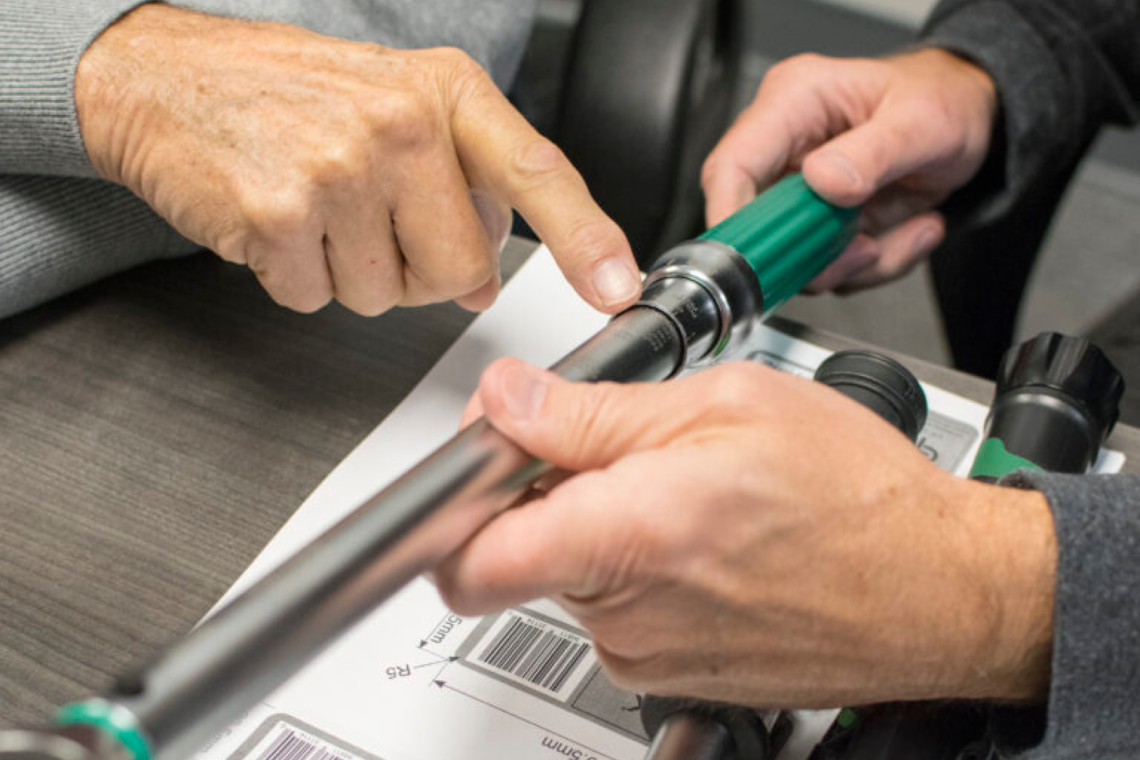The Adjustable Torque Wrench Guide for Mechanics and DIYers
Whether you’re working on an automotive project, assembling equipment, or tackling home repairs, an adjustable torque wrench can be your most versatile tool. Unlike fixed torque wrenches, adjustable models allow you to modify the torque setting for different tasks, making them adaptable to a wide range of applications. This flexibility not only saves time but also helps ensure precision—critical for preventing issues like loose fasteners, which can account for up to 23% of engine failures due to improper torque application. To help you avoid these kinds of potentially catastrophic issues, we put together a guide on the many benefits of adjustable torque wrenches, how to use them properly, and how to choose the right type for your needs.
Benefits of Using an Adjustable Torque Wrench
An adjustable torque wrench offers exceptional versatility, making it a must-have for professionals and DIYers alike. From automotive projects to home repairs, the ability to modify torque settings on the fly allows you to use one tool across a variety of applications, saving both time and money.
Precision is another major benefit. Improper torque can lead to serious issues, including fastener failures and mechanical breakdowns. High-quality adjustable torque wrenches, like those compliant with ISO 6789 standards, maintain accuracy within 4% of the desired torque value for up to 5,000 cycles. This accuracy ensures fasteners are securely tightened, preventing over-torquing that can damage components and under-torquing that can result in loose bolts.
For cost efficiency, an adjustable torque wrench is ideal. It eliminates the need to purchase multiple wrenches for different torque settings, while extending the lifespan of both the tool and the equipment you’re working on. Applying the correct torque not only keeps fasteners secure but also reduces wear and tear on machinery and parts.
Finally, adjustable torque wrenches offer convenience. They’re perfect for users switching between tasks with varying torque requirements. By simply adjusting the settings, you can handle everything from delicate repairs to heavy-duty jobs with one versatile tool.
How to Use Adjustable Torque Wrench
Using an adjustable torque wrench is pretty straightforward, but getting it right is key to ensuring precision and preventing any costly mistakes. Whether you’re a seasoned pro or just starting out, here’s a step-by-step guide to help you use it like a pro.
Step 1: Check Calibration First
Before you dive in, make sure your wrench is calibrated. Over time, torque wrenches can lose their accuracy, especially if they’ve been heavily used. Most experts recommend recalibrating every 5,000 cycles or once a year, whichever comes first. A well-calibrated wrench ensures you’re applying just the right amount of torque—too much or too little can lead to issues down the line.
Quick Tip: Look for a calibration sticker on your wrench to make sure it’s in top shape. If it’s been a while, it might be time for a tune-up!
Step 2: Set Your Torque Value
Now for the fun part: setting your wrench.
- Unlock the Handle: Some wrenches come with a lock to prevent accidental changes. Unlock it before adjusting.
- Dial in the Torque: Twist the handle until your desired torque number lines up with the center line on the scale. This ensures you’re good to go for whatever you’re tightening.
- Lock it in: If your wrench has a locking feature, secure it in place so the torque setting doesn’t shift while you’re working.
Pro Tip: Always stay within your wrench’s recommended range. Don’t push it beyond its limits—usually between 20% and 100% of its maximum capacity—for best accuracy.
Step 3: Position It Right
Proper positioning is key to getting that perfect torque:
- Attach the Right Socket: Make sure you’ve got the right size socket for the fastener you’re working on.
- Hold It at 90 Degrees: Always position the wrench so it’s perpendicular to the fastener. Holding it at an angle can skew your torque readings.
- Grip the Handle Properly: Keep your hand on the handle, not near the head, for the right leverage.
Step 4: Apply Torque (Slow and Steady)
Here’s where the magic happens:
- Apply Steady Pressure: Push down on the handle slowly and steadily. Don’t rush it—you want consistent pressure for an accurate read.
- Listen for the Click: If you’re using a click-type wrench, you’ll hear an audible click once the desired torque is reached. As soon as it clicks, stop applying pressure. Continuing past the click could lead to over-torquing, which can damage parts.
Pro Tip: For dial or digital wrenches, just keep an eye on the display or gauge until you hit the right number.
Step 5: Double-Check Your Work
It never hurts to double-check:
- Inspect the Fastener: After torquing, make sure everything looks secure and undamaged.
- Re-Torque if Necessary: If you’re working on something with multiple fasteners (like an engine head), follow the recommended torque sequence and double-check each one after your first round.
Step 6: Reset and Store
Once you’re done, don’t just toss the wrench in your toolbox:
- Reset to the Lowest Setting: Turning the wrench back to its lowest setting (but not below it) takes the strain off the internal spring, keeping it accurate for longer.
- Store it Safely: Keep your wrench in its case, safe from dust, moisture, and any rough handling. Torque wrenches are precise instruments, and a drop could knock it out of calibration.
Safety Note: Never use a torque wrench to loosen fasteners—it’s designed for tightening only. Using it the wrong way can damage the tool.
Safety Tips:
- Check Specs: Always consult the manufacturer’s recommendations for torque values. Too much torque can strip threads or damage parts, while too little can lead to loose fasteners.
- Use the Right Tools: If you’re working with sensitive or expensive equipment, take extra care to use the correct settings. A small mistake can turn into a big problem later.
By following these steps, you’ll not only extend the life of your wrench but also make sure you’re getting the perfect torque every time.
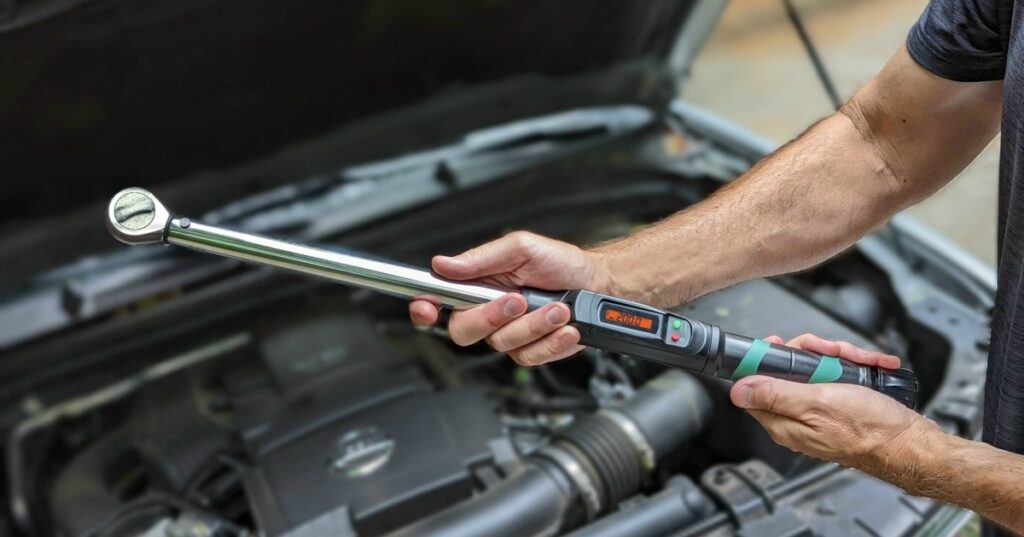
When to Use a Digital Adjustable Torque Wrench
A digital adjustable torque wrench offers a blend of precision and simplicity, with a digital scale that provides easy-to-read torque measurements. These wrenches are particularly useful in situations where quick, accurate torque readings are required but without the need for more complex features like data logging or wireless capabilities.
Here’s when you’ll want to reach for an adjustable digital scale torque wrench:
- Everyday Automotive Projects: For jobs like tightening wheel lug nuts, engine bolts, or working on suspension systems, a digital scale wrench offers an accurate, straightforward solution. The clear display helps ensure that you apply the exact torque needed without having to guess or rely on hard-to-read mechanical scales.
- Precision DIY Work: If you’re into DIY projects—whether it’s assembling furniture, working on bicycles, or doing home repairs—digital scale torque wrenches provide the precision you need with minimal setup. They allow you to easily set the torque value, making them great for hobbyists who need reliable performance without extra features.
- Situations Requiring Quick Adjustments: The digital scale makes it easy to see the current torque setting and adjust it quickly. This is especially helpful when you’re working on projects that require changing torque values frequently, like on custom builds or mechanical assemblies. The real-time display ensures you can fine-tune your settings without slowing down your workflow.
- Clear Readability in Low-Light Conditions: The digital display on these wrenches shines when working in darker environments, such as garages, workshops, or under a vehicle, where a traditional mechanical scale might be difficult to read. This makes digital scale wrenches perfect for mechanics who often work in challenging conditions.
Safety Note: Like any precision tool, it’s important to make sure your digital torque wrench is properly calibrated to avoid applying incorrect torque, which can lead to component damage or safety hazards.
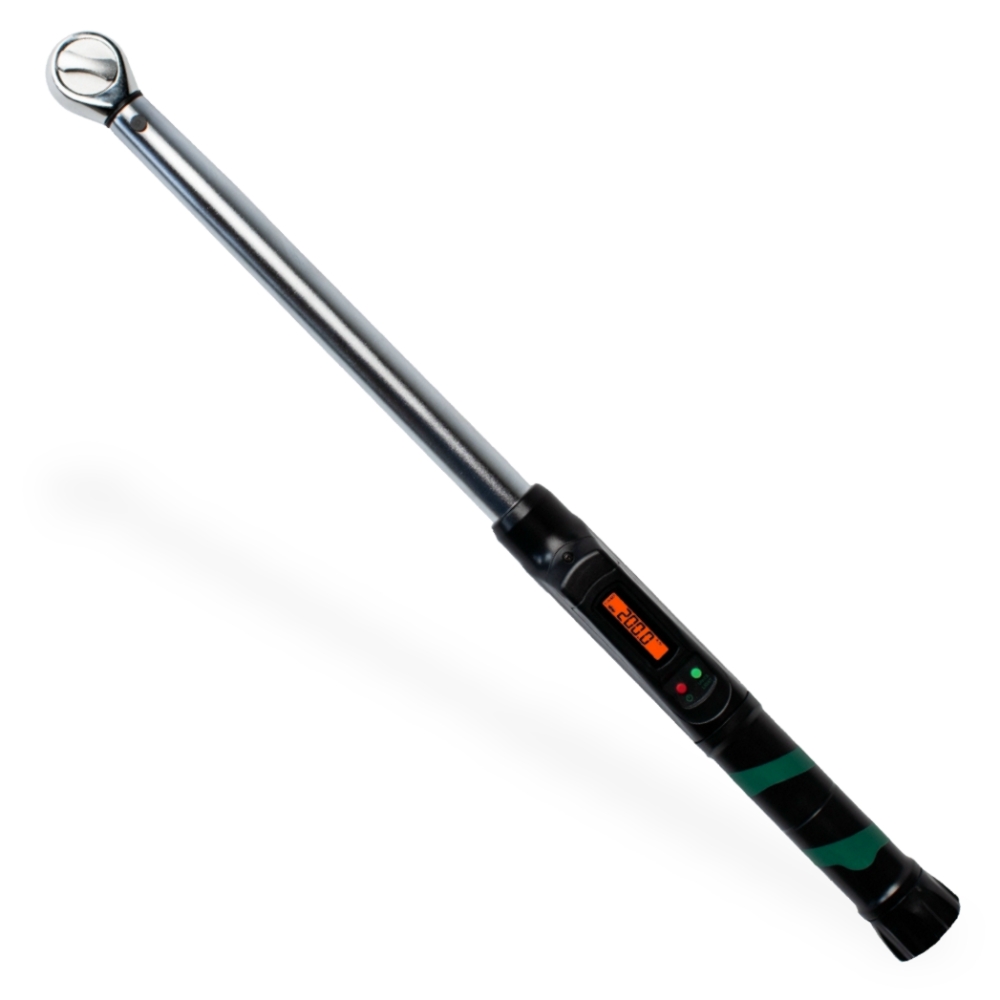
When to Use a Micrometer Adjustable Torque Wrench
A micrometer adjustable torque wrench is all about manual precision and control, ideal for tasks that require exact torque application. These wrenches offer incremental adjustments, making them perfect for high-stakes jobs where torque accuracy is non-negotiable.
Here’s when a micrometer torque wrench is the best choice:
- Automotive and Mechanical Repair: Micrometer wrenches are commonly used in engine assembly, cylinder head installation, and brake system work. Their ability to make fine adjustments ensures that each fastener is tightened to the exact specifications required for safe operation.
- Heavy-Duty Industrial Applications: For technicians working on heavy machinery or large industrial assemblies, a micrometer wrench provides the precision needed to ensure components are fastened correctly, helping to avoid breakdowns or equipment failures due to improper torque.
- Aircraft and Aerospace Work: In the aerospace industry, where safety and precision are critical, micrometer torque wrenches are often the go-to tool. Their precise torque settings help ensure that sensitive components like fasteners on wings or fuselages are secured without risking damage to the material.
- Fine-Tuning and Calibration Work: Micrometer wrenches are excellent for applications where fine-tuning is required, such as in the calibration of instruments or working with sensitive electronic equipment. The high level of accuracy makes them indispensable in these scenarios.
Pro Tip: To maintain the accuracy of a micrometer wrench, regular calibration is essential. Over time, the internal spring mechanism can lose tension, so it’s important to keep the tool properly maintained for accurate results.
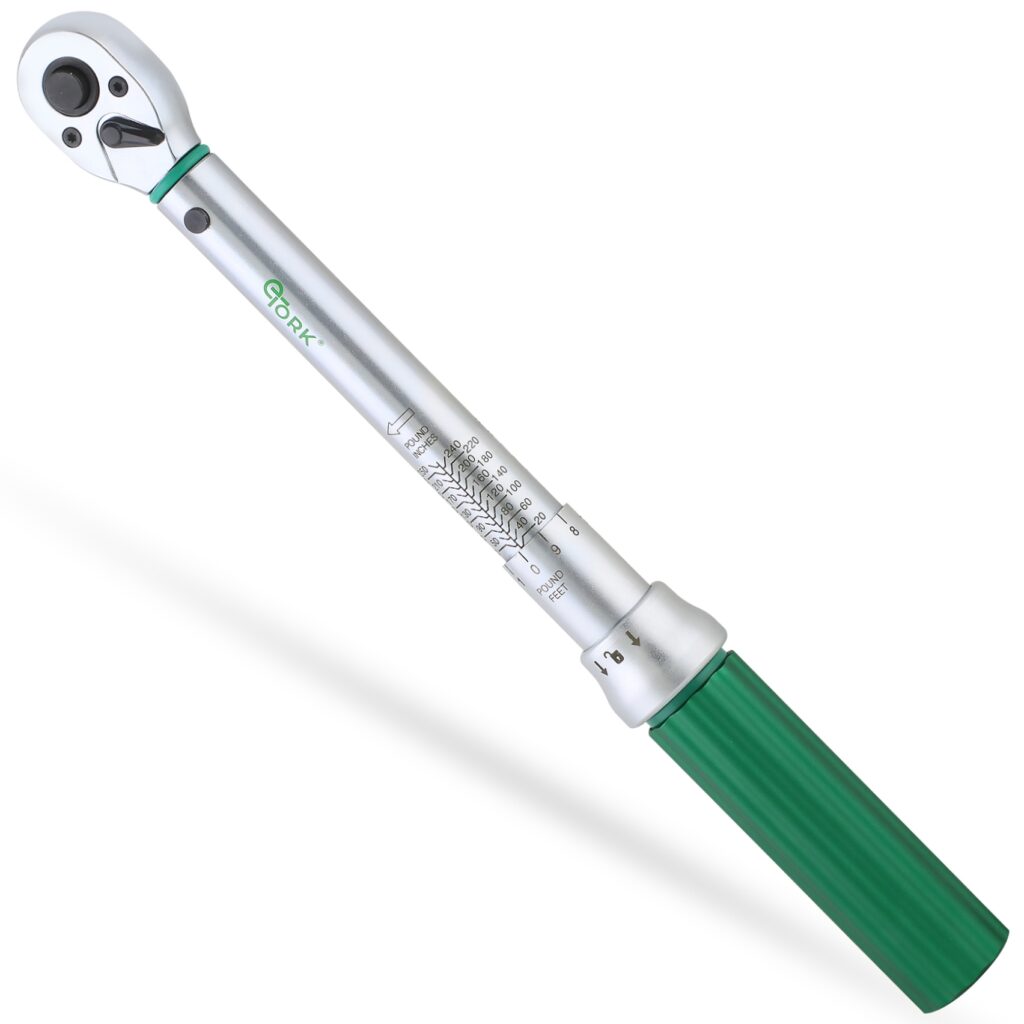
Choosing the Best Adjustable Torque Wrench for Your Project
Selecting the right adjustable torque wrench depends on the type of work you’re tackling. Whether you’re a DIY enthusiast or a professional mechanic, choosing the appropriate tool is essential for ensuring precision, efficiency, and safety. Here’s a breakdown of what to consider for both DIYers and mechanics:
For DIYers
If you’re working on smaller-scale projects, such as home repairs, assembling furniture, or maintaining your bike, the most important factors are ease of use, accuracy, and versatility.
- Torque Range and Drive Size: For most DIY tasks, a 3/8″ drive adjustable torque wrench is ideal, offering torque ranges around 10-100 ft-lbs. This size is versatile enough to handle everything from bike repairs to light automotive work. If you’re working on particularly delicate tasks, such as electronics or small engine work, you might prefer a 1/4″ drive torque wrench, with torque ranges as low as 20-200 in-lbs.
- Simplicity: A digital adjustable torque wrench with a 3/8″ drive offers ease of use, with a clear digital readout, making it a good choice for hobbyists who need precision but don’t require advanced features.
- Durability: Look for a wrench that’s built to last but doesn’t need to meet the high demands of a professional garage. You want a tool that can handle regular use without breaking the bank.
For most DIY projects, a 3/8″ drive wrench with a torque range of 10-100 ft-lbs will cover your bases.
For Mechanics
If you’re working in a professional garage or dealing with automotive engines, heavy equipment, or industrial assemblies, you’ll need a wrench that’s built for precision, durability, and frequent use.
- High Torque Range and Drive Size: Mechanics should look for a 1/2″ drive adjustable torque wrench, which offers a higher torque range—typically 25-250 ft-lbs—to cover more demanding jobs, like engine work or tightening wheel lug nuts.
- Micrometer or Digital Scale Wrenches: For mechanics, a micrometer adjustable torque wrench in a 1/2″ drive provides the fine adjustments needed for precision work. For those who prefer a digital display, a 1/2″ digital scale wrench also offers quick and clear readings for high-torque applications.
- Heavy-Duty Construction: A wrench for mechanics should be able to withstand the rigors of daily use. Look for a 1/2″ drive torque wrench that is durable, precise, and reliable for professional applications.
Be sure to invest in a wrench that can handle more than your heaviest job to ensure longevity. A 1/2″ drive wrench with a range of 25-250 ft-lbs is perfect for most automotive and heavy-duty tasks.
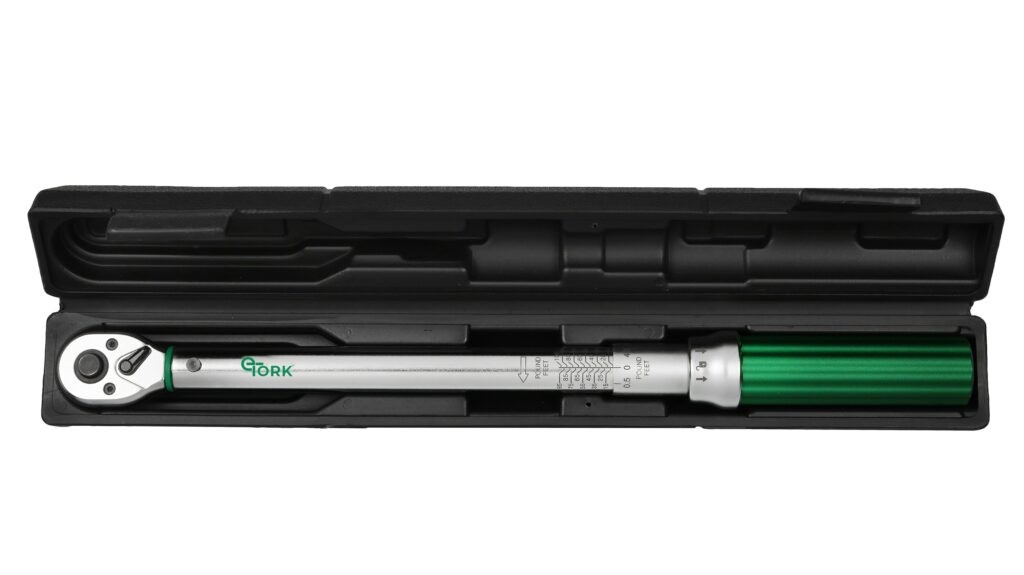
Shop Adjustable Torque Wrenches from eTORK
Now that you know the ins and outs of adjustable torque wrenches and how to choose the right one for your needs, it’s time to find the perfect tool for your next project. At eTORK, we offer a range of high-quality torque wrenches designed for precision, durability, and ease of use. Whether you’re a DIY enthusiast or a professional mechanic, you can count on eTORK’s tools to get the job done right.
Explore our full selection of adjustable torque wrenches here and find the perfect tool to suit your needs!

